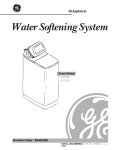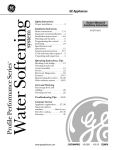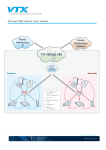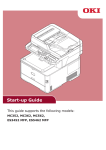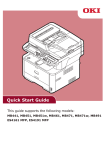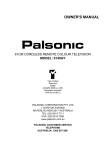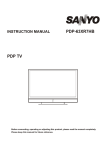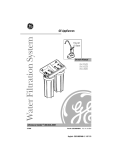Download GE PNSF31Z01 User's Manual
Transcript
Water Softening System Profile ™ GE Appliances Owner’s Manual PNSF31Z01 GE Answer Center ® 800.626.2000 7178935 Part No. 215C1002P002 Pub. No. 49-5800 Congratulations! You Are Now Part of the GE Family. Welcome to the GE family. We’re proud of our quality products and we are committed to providing dependable service. You’ll see it in this easy-to-use Owner’s Manual and you’ll hear it in the friendly voices of our customer service department. Best of all, you’ll experience these values each time you use your water system. That’s important, because your new system will be part of your family for many years. And we hope you will be part of ours for a long time to come. We thank you for buying GE. We appreciate your purchase, and hope you will continue to rely on us whenever you need quality appliances for your home. Important! Staple sales slip or cancelled check here. Proof of the original purchase date is needed to obtain service under the warranty. Write the model and serial numbers here. # # You can find them on the back of the control head. 2 Safety Information . . . . . . .4, 5 Specification Guidelines . . . . . .6 Ask any GE appliance owner and they will tell you we stand behind our products with unmatched quality service. However, did you know that most questions result from simple problems that you can easily fix yourself in just a few minutes? This Owner’s Manual can tell you how. Inside you will find many helpful hints on how to use and maintain your water system properly. Just a little preventive care on your part can save you a great deal of time and money over the life of your system. Troubleshooting Tips Before You Call For Service . . . . . . . . .19–21 You’ll find many answers to common problems here. If you review our chart of Troubleshooting Tips first, you may not need to call for service at all. If You Need Service Customer Service Warranty Information . . . . . . .27 Service Telephone Numbers . . . . . . . . . .Back Cover 3 Customer Service If you do need service, you can relax knowing help is only a phone call away. A list of toll-free customer service numbers is included in the back section. Or you can always call the GE Answer Center® at 800.626.2000, 24 hours a day, 7 days a week. Troubleshooting Tips Review the Section on Troubleshooting Tips Operating Instructions Read this Manual Operating Instructions . .6–16 Care and Cleaning . . . . . . .17, 18 Safety Information GE & You, A Service Partnership. Safety Information IMPORTANT SAFETY INFORMATION. READ ALL INSTRUCTIONS BEFORE USING. WARNING! For your safety, the information in this manual must be followed to minimize the risk of electric shock, property damage or personal injury. Operating Instructions SAFETY PRECAUTIONS Customer Service Troubleshooting Tips ■ Check with your state and local ■ Water softening systems using public works department for sodium chloride (salt) for plumbing and electrical codes. regeneration add sodium to the You must follow these water. Persons on sodium restricted diets should consider guidelines. the added sodium as part of their ■ Use care when handling the overall intake. water softening system. Do not turn upside down, drop, or set ■ The water softening system works on 24 volt-60 Hz on sharp protrusions. Electrical power only. Be sure to use only the included transformer. 4 Safety Information PROPER INSTALLATION This water softening system must be properly installed and located in accordance with the Installation Instructions before it is used. If you did not receive Installation Instructions, you can receive one by calling us toll-free at the GE Answer Center® 800.626.2000. ■ The water softening system requires a minimum water flow of three gallons per minute at the inlet. Maximum allowable inlet water pressure is 125 psi. If daytime pressure is over 80 psi, night time pressure may exceed the maximum. Use ■ Do not install in direct sunlight. a pressure reducing valve if Excessive sun heat may cause necessary. (Adding a pressure distortion or other damage to reducing valve may reduce non-metallic parts. the flow.) ■ Properly ground to conform WARNING: Discard all with all governing codes and unused and packaging ordinances. Follow details in material after installation. Installation Instructions. Operating Instructions ■ Install or store where it will not be exposed to temperatures below freezing or exposed to any type of weather. Water freezing in the system will break it. Do not attempt to treat water over 100°F. Troubleshooting Tips ■ Use only lead-free solder and flux for all sweat-solder connections, as required by state and federal codes. Customer Service 5 Safety Information SPECIFICATION GUIDELINES. Operating Instructions Rated capacity See rating label located on the softener. Amount of high capacity resin (lbs/cu. ft) 41.6/.8 Resin tank nominal size (in., dia. x height) 10 x 35 Service flow rate (gpm) See rating label located on the softener. Water supply maximum hardness (gpg)* 90 Water supply maximum clear water iron (ppm)* 5 Water pressure limits (min-max psi) 20–125 Water temperature maximum (°F.) 120 Water supply minimum flow rate (gpm) 3 *Determined by water analysis from a qualified water testing laboratory. INLET OUT Troubleshooting Tips 11-1/2” 3-3/8” INLET - OUTLET 14” 24” 44” Customer Service 36-1/4” 6 35” Safety Information About the water softening system. Service Soft water OUT Salt storage tank (salt not shown) Hard water IN Resin tank Brine valve Operating Instructions Resin bed When the water softening system is providing soft water, it is called “Service.” During service, hard water flows from the house main water pipe into the water softening system. Inside the water softening system resin tank is a bed made up of thousands of tiny, plastic resin beads. As hard water passes through the bed, each bead attracts and holds the hardness minerals. This is called ion-exchanging. It is much like a magnet attracting and holding metals. Water without the hardness minerals (soft water) flows from the water softening system and to the house pipes. After a period of time, the resin beads become coated with hardness minerals and they have to be cleaned. This cleaning is called regeneration, or recharge. Regeneration is started at 2:00 AM (factory setting) by the water softening system timer, and consists of five stages or cycles. These are FILL, BRINING, BRINE RINSE, BACKWASH and FAST RINSE. Troubleshooting Tips Automatic Hard Water Bypass During Regeneration For emergency needs, hard water is available to the home during the regeneration cycles. However, you should avoid using HOT water because the water heater will fill with the hard water. Fill Soft water OUT Salt dissolved in water is called brine. Brine is needed to clean the hardness minerals from the resin beads. To make the brine, water flows into the salt storage area during the fill stage as shown. Customer Service Salt storage tank Hard water IN Brine valve Fill water 7 Safety Information About the water softening system. Hard water Nozzle & bypass OUT venturi Hard water IN Drain Brine valve During brining, brine travels from the salt storage area into the resin tank. Brine is the cleaning agent needed to remove the hardness minerals from the resin beads. The hardness minerals and brine are discharged to the drain. The nozzle and venturi create a suction to move the brine, maintaining a very slow rate to get the best resin cleaning with the least salt. Brine Operating Instructions Brining Brine Rinse After a pre-measured amount of brine is used, the brine valve closes. Water continues to flow in the same path as during brining, except for the discontinued brine flow. Hardness minerals and brine flush from the resin tank to the drain. Troubleshooting Tips Hard water bypass OUT Hard water IN Drain Backwash During backwash, water travels up through the resin tank at a fast flow rate, flushing accumulated iron, dirt, and sediments from the resin bed and to the drain. Resin bed lifted and expanded Soft water OUT Hard water IN Drain Fast Rinse Backwash is followed by a fast flow of water down through the resin tank. The fast flow flushes brine from the bottom of the tank, and packs the resin bed. Customer Service After fast rinse, the water softening system returns to soft water service. 8 Safety Information SmartWater Softening System RECHARGE TONIGHT RECHARGE NOW TOUCH or HOLD TIME HARDNESS SELECT Operating Instructions Profile Timer Settings Required Upon installation and after an extended power outage. See the Program Memory section. ■ When the transformer is plugged into the electrical outlet 12:00 AM is flashing and PRESENT TIME shows in the display area. Program the timer as instructed below. If SR- - is flashing, use the UP button to set the correct SR code as follows: SR22. If you pass by the correct code number, use the DOWN button. Then, press the SELECT button and program the timer below. Troubleshooting Tips …If the wrong SR code shows for your model, see Manually Initiated Electronic Diagnostics section. ■ A “beeper” sounds while pressing buttons for timer programming. One beep signals a change in the timer display. Repeated beeps mean the timer will not accept a change from the button you have pressed and you should use another button. ■ To set the timer, you will use the UP, DOWN and SELECT buttons. Customer Service Set Present Time of Day NOTE: If the words PRESENT TIME do not show in the display, press the SELECT button until they do. Press the UP or DOWN button to set. The UP button moves the display ahead; the DOWN moves the time backward. If the present time is between noon and midnight, be sure PM shows . If the present time is between midnight and noon, be sure AM shows . When the present time shows in display, press SELECT to set. 1 2 9 Safety Information About the water softening system. Set Water Hardness Number NOTE: If 15 and HARDNESS (factory default) do not show in the display, press SELECT until they do. Press the UP or DOWN button to set your water hardness number in the display. DOWN moves the display down to 1. UP moves the display up to the maximum setting of 90. 1 Operating Instructions NOTE: Each press of a button changes the display by 1 between 1 and 25. Above 25, the display changes 5 at a time…25, 30, 35, etc. Holding a button in changes the numbers twice each second. 2 When the water hardness number shows, press SELECT to set. You can get the grains per gallon (gpg) hardness of your water supply from a water analysis laboratory, or call and ask your local water department, if you are on a municipal supply. Set Regeneration (Starting) Time Troubleshooting Tips NOTE: RECHARGE TIME and a flashing 2:00 AM (factory default) should show in the display. This is a good time for regeneration to start (over in about 2 hours) in most households because water is not in use. HARD WATER is bypassed to house faucets during regeneration. See the Automatic Hard Water Bypass During Regeneration section. Press the UP or DOWN button to set the desired regeneration start time. 1 NOTE: Each press of the buttons changes the time by one hour. Holding the buttons in changes the time twice each second. Be sure to observe the AM or PM as you did when setting the time of day. Press the SELECT button once more. Customer Service 2 10 The display shows the present time of day and RECHARGE . TONIGHT Safety Information Normal Operation, Timer Displays During normal operation, the present time of day and AM or PM shows in the time display area . When the demand computer determines a regeneration is needed, RECHARGE TONIGHT begins to flash in the display, along with the present time. RECHARGE TONIGHT flashes until the next regeneration start time, then changes to RECHARGE NOW, which flashes until the regeneration is over. Operating Instructions Feature: Optional Recharge Controls Sometimes, a manually started regeneration (recharge) may be desired or needed. Two examples: ■ You have used more water than usual (house guests, extra washing, etc.) and you may run out of soft water before the next regeneration. ■ You did not refill the storage tank with salt. Troubleshooting Tips Use one of the following features to start a regeneration immediately, or at the next preset regeneration start time. RECHARGE TONIGHT Touch (do not hold) the TOUCH or HOLD button. RECHARGE TONIGHT flashes in the time display area. A regeneration will occur at the next preset regeneration start time. If you decide to cancel this regeneration, touch the same button once more. RECHARGE NOW Customer Service Press and hold the TOUCH or HOLD button until RECHARGE NOW starts to flash in the time display area. The water softening system begins an immediate regeneration and, when over in about two hours, you will have a new supply of soft water. Once started, you cannot cancel this regeneration. 11 Safety Information About the water softening system. Feature: Program Memory If electrical power to the water softening system is interrupted, the time display is blank, but the timer keeps correct time for about six hours. When power is restored, you have to reset the present time only if the display is flashing. All other settings are maintained and never require resetting unless a change is desired. Operating Instructions If the time is flashing after a long power outage, the water softening system continues to work as it should to provide you with soft water. However, regenerations may occur at the wrong time of day until you reset the timer to the correct time of day. Feature/Service: Automatic Electronic Diagnostics The timer computer has a self-diagnostic function for the electrical system (except input power and water meter). The computer monitors the electronic components and circuits for correct operation. If a malfunction occurs, an error code appears in the timer display. Customer Service Troubleshooting Tips shows the error codes that could The chart on Error Codes appear and possible defects for each code. While an error code is displayed, all timer buttons are inoperable except for the SELECT button. SELECT remains operational so the service person can make the Manually Initiated Electronic Diagnostics to further isolate the defect and check the water meter. 12 Safety Information Service: Electronic Demand Time Features and Service ERR 02 ERR 03 ERR 04 ERR 05 POSSIBLE DEFECT • position switch • motor inoperative or wiring harness • position switch or wiring harness • timer (PWA) • timer (PWA) • timer (PWA) • motor inoperative • wiring harness • timer or connection (PWA) to switch Operating Instructions ERROR CODE DISPLAYED ERR 01 • position switch • timer (PWA) To remove an error code: (1) Unplug transformer. (2) Correct defect. (3) Plug transformer in. (4) Wait for at least 6 minutes. The error code will return if the reason for the error code was not corrected. Service: Timer/Water Softening System, Service Checkout Procedure VISUAL CHECKS: Troubleshooting Tips If you are not getting soft water, and an error code is not displayed, use the procedures below to find the problem. First make the following visual checks. Is there electrical power to the outlet the water softening system 1 transformer is plugged into? 2 Is there sufficient salt in the storage tank? the plumbing bypass valve directing water for soft water 3 Isservice? valve drain hose open to the drain, not elevated too high, 4 Isandtheunobstructed? If you do not find a problem with the visual checks, continue below. TIMER DISPLAY BLANK. TIMER SHOWS WRONG TIME AND DAY, AND/OR FLASHING. Electrical power was off. Reset the correct time of day. Check electrical power to timer (outlet, transformer, power cable, all connections). TIMER DISPLAY SHOWS CORRECT TIME AND DAY AND IS STEADY. Do manual diagnostics. Customer Service NO SOFT WATER Investigate reason for power loss. NO POWER REPAIR AS NEEDED POWER OK TIMER DEFECTIVE Do manual diagnostics to verify proper function. 13 Safety Information About the water softening system. Service: Manually Initiated Electronic Diagnostics Turbine Switches OR Operating Instructions Water Meter (A) Switch (B) To enter diagnostics, press and hold the SELECT button until 1 (000 – –) shows in the display. A The first 3 digits indicate water meter operation as follows: ■ 000 (steady) = soft water not in use…no flow through the meter. —OPEN A NEARBY SOFT WATER FAUCET— ■ 000 to 199 (continual) = repeats display for each gallon of water passing through the meter. Motor Position switch Troubleshooting Tips Valve outlet Sensor housing Turbine Turbine support & shaft If you don’t get a reading in the display, with faucet open, pull the sensor from the valve outlet port. Pass a small magnet back and forth in front of the sensor. You should get a reading in the display. If you get a reading, unhook the in and out plumbing and check the turbine for binding. Customer Service B The letter (P) and dash(es) indicate POSITION switch operation. The letter appearing means the switch is closed; the dash means the switch is open. Use the TOUCH or HOLD (RECHARGE TONIGHT – RECHARGE NOW) button to manually advance the valve into each cycle and check correct switch operation. CORRECT SWITCH DISPLAYS 14 VALVE CYCLE STATUS —— Valve in service, fill, brining, backwash or fast rinse position. —P Valve rotating from one position to another Safety Information C While in this diagnostic screen, the following information is available and may be beneficial for various reasons. This information is retained by the computer from the first time electrical power is applied to the face plate. Operating Instructions ■ Press the UP button to display the number of days this face plate has had electrical power applied. ■ Press the DOWN button to display the number of regenerations initiated by this face plate since the SR code number was entered. CODE Press the SELECT button and hold in three seconds 2 until a Service Rating code appears in the display. For correct water softening system operation, the SR number must be SR22. To reset the code, press the UP or DOWN button until the correct number shows. Troubleshooting Tips SELECT to return to the present time display. 3 IfPress the code was changed, make ALL the timer settings. NOTE: If the face plate is left in a diagnostic display or a flashing display when setting times or hardness, present time automatically returns if a button is not pressed within four minutes. Customer Service 15 Safety Information About the water softening system. Service: Manually Advanced Regeneration Check This check verifies proper operation of the valve motor, brine tank fill, brine draw, regeneration flow rates and other controller functions. First, make the initial checks and the Manually Initiated Electronic Diagnostics. NOTE: The face plate display must show a steady time (not flashing). Operating Instructions the TOUCH or HOLD button and hold in for three seconds. 1 Press RECHARGE NOW begins to flash as the water softening system enters the fill cycle of regeneration. Remove the brinewell cover and, using a flashlight, observe fill water entering the brine tank. If water does not enter the tank, look for an obstructed nozzle, venturi, fill flow plug, brine tubing, or brine valve riser pipe. observing fill, press the TOUCH or HOLD button to move 2 After the water softening system into brining. A slow flow of water to the drain will begin. Verify brine draw from the brine tank by shining a flashlight into the brinewell and observing a noticeable drop in the liquid level. NOTE: Be sure a salt bridge is not preventing water with salt contact. Troubleshooting Tips If the water softening system does not draw brine, check: ■ nozzle and/or venturi dirty or defective. ■ nozzle and venturi not seated properly on gasket. ■ restricted drain (check drain fitting and hose). ■ defective nozzle and venturi seal. ■ other inner valve defect (rotor seal, rotor & disc, wave washer, etc.). NOTE: If water system pressure is low, an elevated drain hose may cause back pressure, stopping brine draw. Again, press the TOUCH or HOLD button to move the water 3 softening system into backwash. Look for a fast flow of water from the drain hose. Customer Service A slow flow indicates a plugged top distributor, backwash flow plug, or drain hose. TOUCH or HOLD button to move the water softening 4 Press system into fast rinse. Again look for a fast drain flow. Allow the water softening system to rinse for a few minutes to flush out any brine that may remain in the resin tank from the brining cycle test. return the water softening system to service, press TOUCH or 5 To HOLD button. 16 Safety Information Care and cleaning of the water softening system. Checking the Salt Storage Level and Refilling Brine (salt dissolved in water) is needed for each and every regeneration. The water for making brine is metered into the salt storage area by the water softening system valve and timer. However, you must keep the tank full of salt. Use clean water softening salts only, at least 99.5% pure. NUGGET, PELLET or coarse SOLAR salts are recommended. Do not use rock, block, granulated or ice cream making salts. They contain dirt and sediments, or mush and cake, and will create maintenance problems. Cleaning Iron Out of the Water Softening System Customer Service Your water softening system takes hardness minerals (calcium and magnesium) out of the water. Also, it can control some (see Specification Guidelines section) “clear water” iron. With clear water iron, water from a faucet is clear when first put into a glass. After 15 to 30 minutes, the water begins to cloud or turn rust colored. A water softening system WILL NOT remove any iron that makes the water cloudy or rusty as it comes from the faucet (called red water iron). To take red water iron out of water, or over the maximum of clear water iron, an iron filter or other equipment is needed. Troubleshooting Tips CAUTION: Water softening salt with iron removing additives: Some salts have an additive to help the water softening system handle iron in the water supply. Although this additive may help to keep the water softening system resin clean, it may also release corrosive fumes that weaken and shorten the life of some water softening system parts. Do not use salt with iron removing additives. Operating Instructions When to refill with salt: Check the salt level a few weeks after you install the water softening system and every week after that. Refill when the brine tank is from 1/3 to 1/2 full. Never allow the water softening system to use all the salt before you refill it. Without salt, you will soon have hard water. If your water supply has clear water iron, periodic resin bed cleaning is needed. Clean the bed at least every six months, or more often if iron appears in the soft water between treatments, using a resin bed cleaner. Follow directions on the resin bed cleaner container. Resin bed cleaner is available from most hardware stores. 17 Safety Information Care and cleaning of the water softening system. Breaking a Salt Bridge 1″–2″ Push tool into salt bridge to break Salt Operating Instructions Pencil mark Broom handle Salt bridge Water level Sometimes, a hard crust or salt bridge forms in the salt storage area. It is usually caused by high humidity or the wrong kind of salt. When the salt bridges, an empty space forms between the water and salt. Then salt will not dissolve in the water to make brine. If the brine tank is full of salt, it is hard to tell if you have a salt bridge. Salt is loose on top, but the bridge is under it. The following is the best way to check for a salt bridge. Salt should be loose all the way to the bottom of the tank. Take a broom handle or like tool, and carefully push it down into the salt, working it up and down. If the tool strikes a hard object (be sure it’s not the bottom or sides of the tank), it’s most likely a salt bridge. Carefully break the bridge with the tool. Do not pound on the walls of the tank. If the wrong kind of salt made the bridge, take it out. Then fill the tank with nugget or pellet salt only. In humid areas, it is best to fill with less salt, more often. Troubleshooting Tips Cleaning the Nozzle and Venturi Assembly Cap O-ring seal Screen support Screen Nozzle & Venturi Screen Gasket *Fill flow plug Customer Service Nozzle & Venturi housing IMPORTANT: Be sure small holes in the gasket are centered directly over the small holes in the nozzle and venturi housing. *INSTALL WITH NUMBERED SIDE UP, CONCAVE SIDE DOWN 18 A clean nozzle and venturi is needed for the water softening system to work properly. This small unit makes the suction to move brine from the salt storage area to the resin tank during regeneration. If it becomes plugged with sand, dirt, etc., the water softening system will not work and you will get hard water. To get to the nozzle and venturi remove the water softening system top cover. Be sure the water softening system is in service cycle (no water pressure at nozzle and venturi). Then, while holding the nozzle and venturi housing with one hand, remove the cap. Lift out the screen support and screen, then the nozzle and venturi. Wash and rinse the parts in warm water until clean. If needed, use a small brush to remove iron or dirt. Also check and clean the gasket. NOTE: Some models have a small flow plug located in the nozzle and venturi, and/or a small cone shaped screen in the housing. Be sure to check and clean these parts, if your model is so equipped. Carefully replace all parts in the correct order. Lightly lubricate the o-ring seal with clean silicone grease or petroleum jelly and place in position. Install and tighten the cap, by hand only. Do not over-tighten the cap or housing. Safety Information Before you call for service… Troubleshooting Tips Review the charts on the following pages first and you may not need to call for service. Possible Causes What To Do Water feels slippery after installation of water softening system Absence of hardness minerals • This is normal. Water softening system not using any salt Water softening system is a “demand” unit • Does not use much salt to regenerate—very efficient. Possible salt bridge • See the Care and Cleaning section. Possible plugged nozzle and venturi • See the Care and Cleaning section. Acidic water in copper plumbing • Have the water tested at once. Water is blue color after water softening system was installed Operating Instructions Problem Troubleshooting Tips WARNING: Do not drink the water until problem has been corrected. • Call for service. Sensor wire corroded • Call for service. Face plate defective • Call for service. No power to unit • Check the circuit breaker or fuses. Cloudiness on glassware (automatic dishwashers) Combination of soft water and too much detergent • This is called etching and is permanent. To prevent this from happening, use less detergent if you have soft water. Wash glassware in the shortest cycle that will get them clean. Salty tasting water after installation Low water pressure • Check pressure; should be minimum 20 psi. Restricted drain hose • Clean and reconnect hose. Customer Service Meter turbine stuck Water softening system not regenerating 19 Safety Information Before you call for service… Troubleshooting Tips Operating Instructions Troubleshooting Tips Problem Possible Causes No soft water Faucet or fixture where •To conserve salt, the installer sample was taken not may have isolated some fixtures plumbed to soft water. (outside faucets, toilets, etc.) NOTE: Be sure sample is from soft water. From the outlet from a faucet that does not of the water softening system, mix soft and hard water. For trace the water flow path, in example, a single lever house plumbing. If soft water kitchen faucet, if the cold is not directed to a faucet or side is plumbed to hard water fixture where wanted, consult a plumber. No salt in the brine tank or salt bridged •Check for a salt bridge or, if the tank is empty, refill with recommended salt. Press (for 3 seconds) the TOUCH or HOLD button to start an immediate regeneration and restore soft water supply. Transformer unplugged at wall outlet or power cable to water softening system not connected •Check for a loss of electrical power to the water softening system due to any of these conditions and correct as needed. With the power supply restored, observe the face plate time display and read Program Memory section. Fuse blown or circuit breaker popped on circuit to electrical outlet Customer Service Electrical outlet on a circuit that can be switched off 20 What To Do NOTE: The electrical outlet for the water softening system should be continuously live so it cannot be switched off. Manual bypass valve in bypass position •Be sure the bypass valve stem is positioned properly. Observe instruction on the decal at the end of the stem. Valve drain hose pinched, plugged, elevated too high or otherwise restricted •Any restriction in this drain hose may prevent proper operation of the nozzle and venturi and reduce or prevent brine draw during regenerations. No soft water Nozzle and venturi dirty, incorrectly assembled or damaged •With water pressure to the water softening system off, take the nozzle assembly apart. Inspect, clean and replace as needed. Any foreign particle(s), scratches, nicks, etc., in the passages can prevent operation. Be sure holes in the gasket are centered over holes in the housing. Resin beads showing up in drinking water and sink Cracked distributor •Call for service. Sounds you might hear Running water from the unit into a drain •This is normal. Water has air bubbles and is cloudy Air in system after installation •Will go away after it runs for a while. Water hard sometimes Using hot water while the water softening system is regenerating •Avoid using hot water during water softening system regenerations because the water heater will refill with hard water. See Automatic Hard Water Bypass During Regeneration section. Timer hardness number setting too low •Press and release the SELECT button until HARDNESS shows in the display. Be sure the number shown is the same as the actual grains per gallon hardness of your water supply. See the Timer section if a change in the setting is needed. Grains of hardness in your water supply have increased •Water hardness can change over time, especially in well water. To check, have the water tested by a water analysis laboratory or call your local water department. Adjust the hardness number setting as needed. Troubleshooting Tips What To Do Operating Instructions Possible Causes Safety Information Problem Customer Service 21 Customer Service Troubleshooting Tips Operating Instructions Safety Information Notes 22 Safety Information Notes Operating Instructions Troubleshooting Tips Customer Service 23 Customer Service Troubleshooting Tips Operating Instructions Safety Information Notes 24 GE Appliances Consumer Product Ownership Registration Important Mail Today Place in an envelope and mail to: General Electric Company Warranty Registration Department P.O. Box 34070 Louisville, KY 40232-4070 25 Consumer Product Ownership Registration Dear Customer: Thank you for purchasing our product and thank you for placing your confidence in us. We are proud to have you as a customer! Follow these three steps to protect your new appliance investment: Complete and mail your Consumer Product Ownership Registration today. Have the peace of mind of knowing we can contact you in the unlikely event of a safety modification. After mailing the registration below, store this document in a safe place. It contains information you will need should you require service. Our service number is 800-GE-CARES. (800-432-2737). 1 2 3 Product Model Read your “Owner’s Manual” carefully. It will help you operate your new appliance properly. If you have questions, or need more information call the GE Answer Center® 800.626.2000. Serial WATER TREATMENT Important: If you did not get a registration card with your product, detach and return the card below to ensure that your product is registered. ✂ Consumer Product Ownership Registration Product Model WATER TREATMENT First Name Mr. ■ Ms. ■ Mrs. ■ Serial Im po rt ToMail ant da y! Miss ■ Last Name Street Address Apt. # State Date Placed In Use Month Phone Number ✂ City Zip Code Day _ Year _ GE Appliances General Electric Company Louisville, Kentucky 40225 Safety Information GE Water Softening System Warranty All warranty service provided by our SmartWater™ Authorized Servicer Network. For service, call 800-GE-CARES. GE Will Replace: One Year From the date of the original purchase Any part of the Water Softening System which fails due to a defect in materials or workmanship. During this full one-year warranty, GE will also provide, free of charge, all labor and in-home service to replace the defective part. Three Years From the date of the original purchase The electronic monitor, if it fails due to a defect in materials or workmanship. During this three-year limited warranty, you will be responsible for any labor or in-home service costs. Ten Years From the date of the original purchase A replacement cabinet (brine tank) or resin tank, if either fails due to a defect in materials or workmanship. During this ten-year limited warranty, you will be responsible for any labor or in-home service costs. Operating Instructions For The Period Of: Troubleshooting Tips What GE Will Not Cover: ■ Service trips to your home to teach you how to use the product. ■ Replacement of house fuses or resetting of circuit breakers. ■ Improper installation. ■ Damage to the product caused by accident, fire, floods or acts of God. ■ Failure of the product if it is abused, misused, or used for other than the intended purpose or used commercially. ■ Incidental or consequential damage to personal property caused by possible defects with this appliance. ■ Filters, membranes or batteries. Customer Service This warranty is extended to the original purchaser and any succeeding owner for products purchased for home use within the USA. In Alaska, the warranty excludes the cost of shipping or service calls to your home. Some states do not allow the exclusion or limitation of incidental or consequential damages. This warranty gives you specific legal rights, and you may also have other rights which vary from state to state. To know what your legal rights are, consult your local or state consumer affairs office or your state’s Attorney General. 27 Safety Information Service Telephone Numbers. GE Answer Center ® 800.626.2000 The GE Answer Center® is open 24 hours a day, 7 days a week. In-Home Repair Service 800-GE-CARES (800-432-2737) Operating Instructions Expert GE repair service is only a phone call away. Special Needs Service 800.626.2000 TDD 800-TDD-GEAC (800-833-4322) GE offers, free of charge, Braille controls for a variety of GE appliances and a brochure to assist in planning a barrier-free kitchen for persons with limited mobility. Customer Service Troubleshooting Tips Service Contracts 800-626-2224 Purchase a GE service contract while your warranty is still in effect and you’ll receive a substantial discount. GE Consumer Service will still be there after your warranty expires. Parts and Accessories 800-626-2002 Individuals qualified to service their own appliances can have parts or accessories sent directly to their homes (VISA, MasterCard and Discover cards are accepted). Instructions contained in this manual cover procedures to be performed by any user. Other servicing generally should be referred to qualified service personnel. Caution must be exercised, since improper servicing may cause unsafe operation. Service Satisfaction If you are not satisfied with the service you receive from GE, follow these steps. First, contact the people who serviced your appliance. If you are still not pleased, write all the details—including your phone number—to: Manager, Consumer Relations, GE Appliances, Appliance Park, Louisville, KY 40225. Printed in Louisville, KY 4-97 CG




























